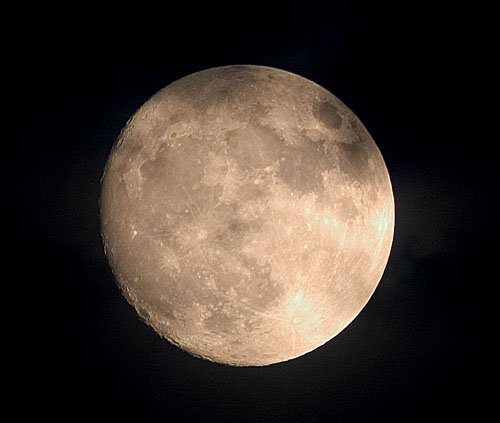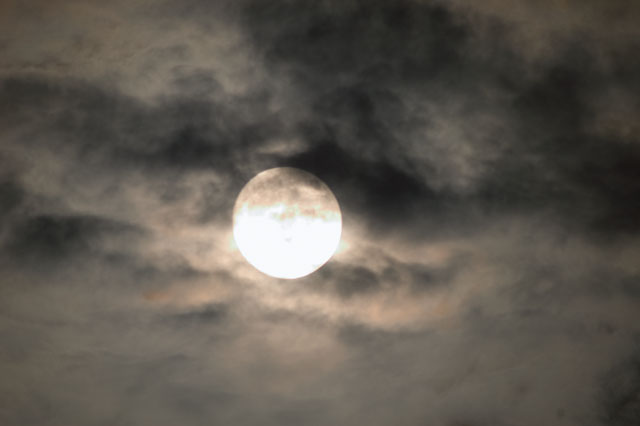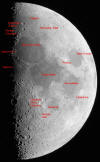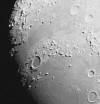
7/19/2005, The biggest moon of the year. Thanks to Max for the phone call. This and right: Nikon D100 DSLR, 300mm f2.8 lens, 1.4x extender, tripod. | 
Spooky Moon
As you can see, I had to contend with some low clouds. I kind of like this shot. Note you can see some clouds on the left image, also. 7/19/2005 |

First: Large Image of the moon 12/18/04 with Nikon DSLR, TOA 130, 1.6 extender, Nikon D100. | 
Above: Large image of moon 12/19/04, similar to above, 1/50s exposure ISO 200 setting on D100. Check both the upper left and lower right areas of the terminator for some interesting shadows. |

Above: same moon, with features labeled. | Close up of above upper left at full camera resolution-> 
Looks like Plato (dark crater mid lower left), and the Valles Alpes (slash in the middle).
|
| See EP projection close-ups here. | 10/8/05 Moon - Very Close/Large!  |
Notes about the bottom-left image above: Thanks to Jim Mosher for identifying the features and other info. The wavelet software allows you to tune the image to bring out your features such as the trench/fracture on the upper left part, and the rilles on the upper right. 12/19/04

Above: Jim Mosher put together this cool montage! Jim provided all the additional info below, thanks Jim!
At the bottom of your NexImage Moon Pictures webpage ( http://www.dl-digital.com/astrophoto/neximage-moons.htm )you show six photos of the lunar terminator ask if anyone can help you identify the location of the lower left photo (“leftmoon3.jpg”).
You have probably figured this out long ago, but the crater in the upper left is Agrippa and the one above the center is Manilius. The V-shaped below and to the left of center is connected with the crater Ukert.
If we call the photos in the first row 1..3, and those in the second row 4..6, then this one (#4) actually fits between and overlaps with #1 and #2. In fact, you can see the crater Agrippa in the upper left of #2, and the hills in the left part of the photo you labeled “Mare Serenitatus” (#1) are seen along the left side of the mystery photo (#4).
I am attaching a photo you might be interested in taken by Canadian amateur Joseph Carr ( http://www.joecarr.ca/astro/astrophoto-moon.htm ) showing the Moon at a very similar phase (but not nearly as sharply) with the locations of your six photos indicated. Carr was also impressed by the “x” feature.
I am attaching a quick and dirty composite of 5 of your frames which I used to compare to the other photos in the database. This is not meant to be pretty; just functional. Your photos have been mirrored and rotated to put them in the standard configuration with north at top. Also, the gamma has been unmercifully increased to bring out whatever shadow detail can be detected along the terminator. Compared to Carr's photo (taken at 10:56 CST on Dec. 18, 2004), the wall of the large crater at the bottom of the attached composite (indicated by the yellow arrow = Walter) is less fully in sunlight in your photo than in his. This suggests your photo was taken about an hour earlier.
If you are still interested in the trench and rilles in the photo you call leftmoon3.jpg, you may wish to go to the following website:
http://www.cambridge.org/us/catalogue/catalogue.asp?isbn=0521622743&ss=sam
There you can download a sample chapter from the book Observing the Moon by Gerald North. If you look at Figure 2.8 (on page 39) you will see a photo of the same region taken at a very similar sun angle with a 74-inch telescope in the 1960's (Note: the figure is printed with South up, which was the convention at one time).
If you have a PC and are not already familiar with it, the free Virtual Moon Atlas is an excellent tool for learning about lunar features. I am certainly no expert myself, but the most prominent rille in leftmoon3.jpg (the one with the little crater straddling it) is, according to VMA, Rima Hyginus, while the little crater itself is named Hyginus.
Visual index of my moon photos here.
Astronomy Pictures: Dick Locke's Astrophoto Gateway page....
Images Home

Copyright © 2004-2006, Dick Locke. All Rights Reserved.
Contact and Image Use Information













